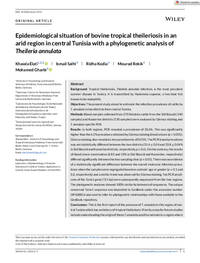Epidemiological situation of bovine tropical theileriosis in an arid region in central Tunisia with a phylogenetic analysis of Theileria annulata

Authors:
Background
Tropical theileriosis, Theileria annulata infection, is the most prevalent summer disease in Tunisia. It is transmitted by Hyalomma scupense, a two-host tick known to be endophilic.
Objectives
The present study aimed to estimate the infection prevalence of cattle by T. annulata in two districts from central Tunisia.
Methods
Blood samples collected from 270 Holstein cattle from the Sidi Bouzid (140 samples) and Kasserine districts (130 samples) were analysed by Giemsa staining and T. annulata-specific PCR.
Results
In both regions, PCR revealed a prevalence of 32.6%. This was significantly higher than the 6.3% prevalence obtained by Giemsa staining blood smears (p < 0.001). Giemsa staining also revealed a low parasitaemia of 0.05%. The PCR-based prevalence was not statistically different between the two districts (31.4 ± 0.04 and 33.8 ± 0.04% in Sidi Bouzid and Kasserine districts, respectively, p = 0.6). On the contrary, the results of blood smear examination (2.85 and 10% in Sidi Bouzid and Kasserine, respectively) differed significantly between the two sampling sites (p = 0.01). There was no evidence of a statistically significant difference between the overall molecular infection prevalence when the samples were segregated based on animals’ age or gender (p = 0.1 and 0.2, respectively) and a similar trend was observed for Giemsa staining. Ten PCR amplicons of the Tams1 gene (721 bp) were subsequently sequenced from the two regions. The phylogenetic analyses showed 100% similarity between all sequences. The unique conserved Tams1 sequence was deposited in GenBank under the accession number OP428816 and used to infer its phylogenetic relationships with those available in the GenBank repository.
Conclusions
This is the first report of the presence of T. annulata in this region of central Tunisia which has no history of tropical theileriosis. Priority areas for future studies include understanding the origin of these T. annulata-positive animals in a region where the presence of a known natural vector tick, H. scupense, has not been reported. Given that the disease severely constrains cattle productivity, it would also be worthwhile to investigate if other potential vectors for T. annulata, such as Hyalomma dromedarii, are present in the arid regions.
